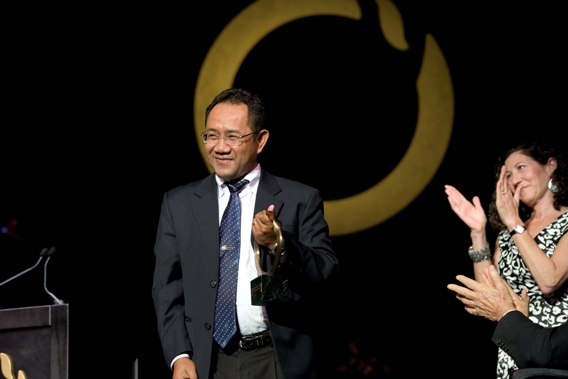
Tuy Sereivathana receiving his award at the 2010 Goldman Prize ceremony. Photo courtesy of the Goldman Environmental Prize.
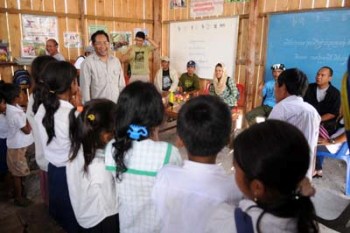
Tuy Sereivathana in a school he helped to create. Photo courtesy of: Tuy Sereivathana
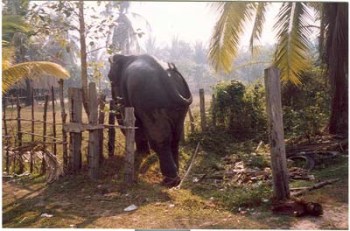
Wild elephant raid in Vield Reahn village. Photo courtesy of: Tuy Sereivathana
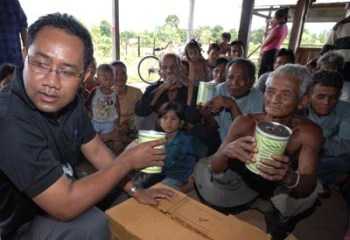
Tuy Sereivathana providing crop seeds to farmers affected by human-elephant conflict. Photo courtesy of: Tuy Sereivathana
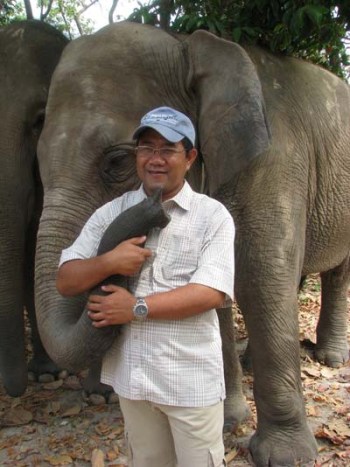
Tuy Sereivathana with an Asian elephant. Photo by: Tom Dusenbery.
Jeremy Hance
mongabay.com
May 17, 2010
Since winning the prestigious 2010 Goldman Environmental Prize in Asia, Tuy Sereivathana has visited the US and Britain, even shaking hands with US President Barack Obama, yet in his home country of Cambodia he remains simply 'Uncle Elephant'. A lifelong advocate for elephants in the Southeast Asian country, Sereivathana's work has allowed villagers and elephants to live side-by-side. Working with Fauna and Flora International (FFI) he has successfully brought elephant-killing in Cambodia to an end. As if this were not enough, Sereivathana has helped curb the destruction of forests in his native country and built four schools for children who didn't previously have formal education opportunities.
Mongabay.com recently reached Sereivathana while he was in London for the Elephant Parade—a showcase of Asian Elephants statues around the city to help raise conservation funds to save the species (to read more about the parade: Elephants march in London, trumpeting conservation).
When asked how he felt on hearing the news that he had won this year's Goldman Environmental Prize (often dubbed the 'Nobel Prize' for the environment), Sereivathana said, "my wife and I dropped tears from surprise and excitement. I sat down and remembered my childhood till the day that I started working with elephant conservation."
Tuy Sereivathana with an Asian elephant. Photo by: Tom Dusenbery.
Like Cambodia's recent history, Sereivathana's path has not been easy. Sereivathana was born in 1970—the very year King Sihanouk of Cambodia was overthrown. From the ensuing power struggle rose the Khmer Rouge and its head, genocidal dictator Pol Pot. Fearing the new order, Sereivathana's parents escaped from the city of Phnom Penh to a small village deep in the countryside of Cambodia.
It was there, living a decidedly rural life, that Sereivathana had his first encounter with the Asian elephant. Visiting the village, two mahouts and their domestic elephants allowed young Sereivathana to pummel them with questions. Seeing an elephant for the first time changed the course of his life.
"That night, all members of my family were sleeping deeply well except me. I imagined large groups of wild elephants with their babies in large forest. I wanted to work as an elephant protector (in that time we didn’t know the word 'conservationist' yet)," writes Sereivathana.
Years later Sereivathana received a government scholarship and studied in Minsk, Belarus. On returning to Cambodia after a seven year absence, Sereivathana worked in forestry, but eventually began his lifelong dream of working with elephants when FFI granted him the opportunity.
"In 2003, two elephant experts from FFI Cambridge went to meet my boss, Mr.Chey Samith, director of department of Nature Conservation and Protection (DNCP)," Sereivathana explains. "They needed a government officer who has strong commitment on elephant conservation to cooperate with an elephant project. My chance came. I became involved with elephant conservation from that time on."
Before Sereivathana's involvement elephants were killed regularly in southwest Cambodia amid the Cardamom Mountains because they were viewed as a pest who increasingly raided farmers' crops.
Tuy Sereivathana providing crop seeds to farmers affected by human-elephant conflict. Photo courtesy of: Tuy Sereivathana
Sereivathana says the conflict was exacerbated by habitat loss which forced many elephants out of the forest and into agricultural areas. New villages and new crops encroached on elephant habitat and even their long-trodden corridors.
After working to gain the farmers' trust, Sereivathana implemented several low-cost measures to keep elephants away from farmers' fields, thereby mitigating conflict and ulimtately protectingthe 250 or so elephants that survived in the region.
Employing a variety of highly creative methods—including carbide explosions to scare marauding elephants, electric fences powered by solar panels, hanging hammocks and hats to confuse elephants into thinking people were there, placing chili in ropes and dung to keep elephants away, and encouraging farmers to switch to less elephant-friendly crops—Sereivathana successfully brought elephant mortalities from human conflict down to zero. In fact, not a single elephant has been killed in Cambodia since 2005, the year Sereivathana started working with FFI fulltime.
Even more than this, Sereivathana has become a local ambassador not just for elephants but for the tropical ecosystems of the Cardamom Mountains, which house a variety of rare and endangered species, including the Indochinese tiger, the pileated gibbon, the Siamese crocodile, and the wild cattle known as kouprey which may already be extinct.
"My project worked with people to stop going into the forest (where they cut trees or timbers) through providing training courses on agronomics and chicken farming," explains Sereivathana. "We also provided crop seeds, handle tractors, and made agreements with wildlife hunters and loggers."
Wild elephant raid in Vield Reahn village. Photo courtesy of: Tuy Sereivathana
Sereivathana attributes much of his success to working closely with the poor agraian communities, in other words he has paid as much attention to human needs as to the elephant's.
"We also build trust with local community and local authority. Conservation base with human needs is one of the most important," says Sereivathana.
Along this line, Sereivathana developed a program which built four community schools inside elephant areas.
"I knew villagers [were] concerned about future of their kids (who are illiterate). We helped to create the schools and provided teachers: these are indirect ways to improve elephant conservation in the areas. The teachers choose one day per week to do education on elephant conservation or value of forest to students such as read story books about wildlife, forests, and elephants," Sereivathana says, adding that by teaching children one also reaches adults.
"When the students return home, they talk positively about elephants. It can help villagers to change their mind on elephant conservation and also bring mainstream elephant conservation to a new generation."
Asian elephants, Sereivathana says, have always been important to Cambodians: "[they] played one of the main roles in building Angkor Wat [and] many Cambodian stories and songs show very deep relationship between elephant and our culture."
It has just taken a passionate advocate like Sereivathana to remind locals to see elephants differently: not as enemies, but more like eccentric five ton neighbors.
Tuy Sereivathana in a school he helped to create. Photo courtesy of: Tuy Sereivathana
"The elephant is a flagship species," says Sereivathana, who sees elephants as possessing a vital ecological niche in his nation's forests. "To conserve the elephant, we have to think about their habitat (they need large forest), so other species can survive in the habitat. In case of water sources during the dry season, elephants make water holes by trampling, so other wildlife also use the water source. Elephants spread out seeds of trees in forest."
Even the dung of Asian elephants has been recently discovered to provide an important link between elephants and other forest species. Researchers have found life blooming amid the dung: fungi, insects, and even tiny frogs.
When asked what advice Sereivathana would give future Cambodian conservationists, he had this to say: "We must join as strong friends and try to improve our capacity day to day, support each other. Hopefully, many of us can show face in global community. Please don’t hesitate or be shy to show our effort and achievement; especially don’t feel negative about your future."
Sereivathana has proven just how much one person's dedication and passion can impact the future of one of the world's most beloved species, the Asian elephant, but more importantly he's achieved success by bettering the lives of the people who share the elephants' habitat.
Mongabay.com recently reached Sereivathana while he was in London for the Elephant Parade—a showcase of Asian Elephants statues around the city to help raise conservation funds to save the species (to read more about the parade: Elephants march in London, trumpeting conservation).
When asked how he felt on hearing the news that he had won this year's Goldman Environmental Prize (often dubbed the 'Nobel Prize' for the environment), Sereivathana said, "my wife and I dropped tears from surprise and excitement. I sat down and remembered my childhood till the day that I started working with elephant conservation."
Tuy Sereivathana with an Asian elephant. Photo by: Tom Dusenbery.
Like Cambodia's recent history, Sereivathana's path has not been easy. Sereivathana was born in 1970—the very year King Sihanouk of Cambodia was overthrown. From the ensuing power struggle rose the Khmer Rouge and its head, genocidal dictator Pol Pot. Fearing the new order, Sereivathana's parents escaped from the city of Phnom Penh to a small village deep in the countryside of Cambodia.
It was there, living a decidedly rural life, that Sereivathana had his first encounter with the Asian elephant. Visiting the village, two mahouts and their domestic elephants allowed young Sereivathana to pummel them with questions. Seeing an elephant for the first time changed the course of his life.
"That night, all members of my family were sleeping deeply well except me. I imagined large groups of wild elephants with their babies in large forest. I wanted to work as an elephant protector (in that time we didn’t know the word 'conservationist' yet)," writes Sereivathana.
Years later Sereivathana received a government scholarship and studied in Minsk, Belarus. On returning to Cambodia after a seven year absence, Sereivathana worked in forestry, but eventually began his lifelong dream of working with elephants when FFI granted him the opportunity.
"In 2003, two elephant experts from FFI Cambridge went to meet my boss, Mr.Chey Samith, director of department of Nature Conservation and Protection (DNCP)," Sereivathana explains. "They needed a government officer who has strong commitment on elephant conservation to cooperate with an elephant project. My chance came. I became involved with elephant conservation from that time on."
Before Sereivathana's involvement elephants were killed regularly in southwest Cambodia amid the Cardamom Mountains because they were viewed as a pest who increasingly raided farmers' crops.
Tuy Sereivathana providing crop seeds to farmers affected by human-elephant conflict. Photo courtesy of: Tuy Sereivathana
Sereivathana says the conflict was exacerbated by habitat loss which forced many elephants out of the forest and into agricultural areas. New villages and new crops encroached on elephant habitat and even their long-trodden corridors.
After working to gain the farmers' trust, Sereivathana implemented several low-cost measures to keep elephants away from farmers' fields, thereby mitigating conflict and ulimtately protectingthe 250 or so elephants that survived in the region.
Employing a variety of highly creative methods—including carbide explosions to scare marauding elephants, electric fences powered by solar panels, hanging hammocks and hats to confuse elephants into thinking people were there, placing chili in ropes and dung to keep elephants away, and encouraging farmers to switch to less elephant-friendly crops—Sereivathana successfully brought elephant mortalities from human conflict down to zero. In fact, not a single elephant has been killed in Cambodia since 2005, the year Sereivathana started working with FFI fulltime.
Even more than this, Sereivathana has become a local ambassador not just for elephants but for the tropical ecosystems of the Cardamom Mountains, which house a variety of rare and endangered species, including the Indochinese tiger, the pileated gibbon, the Siamese crocodile, and the wild cattle known as kouprey which may already be extinct.
"My project worked with people to stop going into the forest (where they cut trees or timbers) through providing training courses on agronomics and chicken farming," explains Sereivathana. "We also provided crop seeds, handle tractors, and made agreements with wildlife hunters and loggers."
Wild elephant raid in Vield Reahn village. Photo courtesy of: Tuy Sereivathana
Sereivathana attributes much of his success to working closely with the poor agraian communities, in other words he has paid as much attention to human needs as to the elephant's.
"We also build trust with local community and local authority. Conservation base with human needs is one of the most important," says Sereivathana.
Along this line, Sereivathana developed a program which built four community schools inside elephant areas.
"I knew villagers [were] concerned about future of their kids (who are illiterate). We helped to create the schools and provided teachers: these are indirect ways to improve elephant conservation in the areas. The teachers choose one day per week to do education on elephant conservation or value of forest to students such as read story books about wildlife, forests, and elephants," Sereivathana says, adding that by teaching children one also reaches adults.
"When the students return home, they talk positively about elephants. It can help villagers to change their mind on elephant conservation and also bring mainstream elephant conservation to a new generation."
Asian elephants, Sereivathana says, have always been important to Cambodians: "[they] played one of the main roles in building Angkor Wat [and] many Cambodian stories and songs show very deep relationship between elephant and our culture."
It has just taken a passionate advocate like Sereivathana to remind locals to see elephants differently: not as enemies, but more like eccentric five ton neighbors.
Tuy Sereivathana in a school he helped to create. Photo courtesy of: Tuy Sereivathana
"The elephant is a flagship species," says Sereivathana, who sees elephants as possessing a vital ecological niche in his nation's forests. "To conserve the elephant, we have to think about their habitat (they need large forest), so other species can survive in the habitat. In case of water sources during the dry season, elephants make water holes by trampling, so other wildlife also use the water source. Elephants spread out seeds of trees in forest."
Even the dung of Asian elephants has been recently discovered to provide an important link between elephants and other forest species. Researchers have found life blooming amid the dung: fungi, insects, and even tiny frogs.
When asked what advice Sereivathana would give future Cambodian conservationists, he had this to say: "We must join as strong friends and try to improve our capacity day to day, support each other. Hopefully, many of us can show face in global community. Please don’t hesitate or be shy to show our effort and achievement; especially don’t feel negative about your future."
Sereivathana has proven just how much one person's dedication and passion can impact the future of one of the world's most beloved species, the Asian elephant, but more importantly he's achieved success by bettering the lives of the people who share the elephants' habitat.

No comments:
Post a Comment